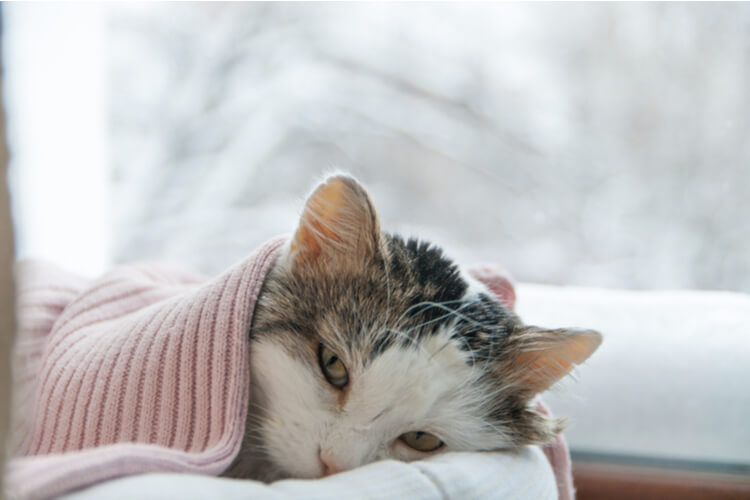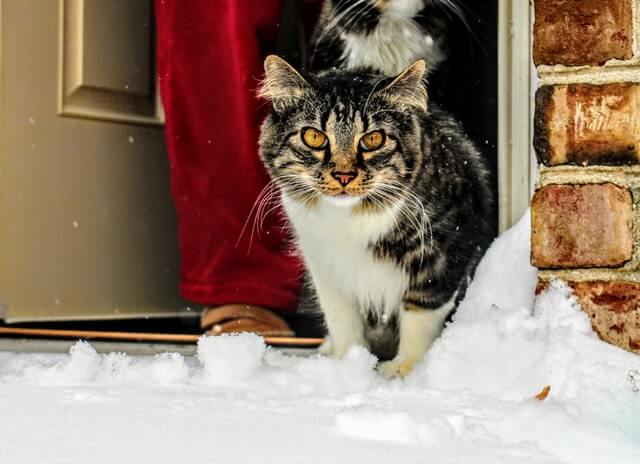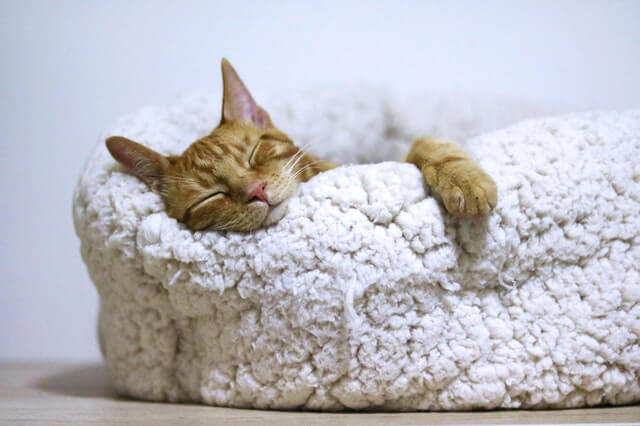As the leaves turn colors and fall from the trees, you’re probably pulling out your fleece blankets, hot tea, and wool sweaters in an effort to stay warm. With their furry coats, it may never have occurred to you that your cat is cold, as well. Whether indoors or out, cats do get cold, fortunately not as easy as we do (cats can even catch colds of their own).1
When Can Cats Get Cold?
Even with the insulation that fur provides, it’s not impenetrable. That being said, most cats acclimate pretty well to the cold, especially if it comes on gradually. This means that if temperatures slowly drop, your kitty’s haircoat will kick in to keep them warm in most conditions. However, if those temperatures drop overnight, it can be a different story.
Cats that live outside have an arsenal of cold-fighting weapons, including a thick hair coat, body fat, and hopefully a nice shelter. But they also have to contend with more than just cold. Wind, rain, or snow can add up to more than a winter hair coat or cat house can handle.
Outdoor kitties are most vulnerable to cold, of course, but indoor cats can still be at risk as well. Even in a heated home, cats can get locked in colder places in the home, such as the attic or basement, and get cold. They can also get cold if you adjust the thermostat too low when you’re out of the house or if the power goes out so that the heat isn’t on.
Kitties can also get colder if they have shorter or thinner hair, are underweight, or have medical conditions that affect circulation and other body heat regulators. Hyperthyroidism, kidney disease, heart disease, or cancer can all decrease how well your cat handles cooler temps.
How Cold is Too Cold for Cats?
Image courtesy of Pexels
If you’re looking for a numerical trigger to help to decide if your cat is cold or not, generally speaking, anything below 45℉ is too cold for a kitty. Of course, this temperature is going to vary dramatically if your cat isn’t acclimated to cooler temperatures or if they have a poor haircoat or underlying health condition.
For indoor cats, that temperature may be much higher, especially if they don’t go outside. This is just because they are used to higher indoor temperatures and won’t adjust to handling the cold very quickly.
What Are the Signs That a Cat is Cold?
At the first sign of chilliness, you may notice that your cat sits hunched up with its feet underneath them. They definitely won’t be sprawled on their side out on the floor. They may even shiver or curl into a tight ball with their tail over their nose. They aren’t going to want to play or move much and may not want to eat. Cold kitties will also seek out warm spaces, such as a sunbeam, under covers, on top of the dog, or in the direct path of the heater.
If a cat gets too cold for too long, it can develop hypothermia or even frostbite.23 Hypothermia can become very serious very quickly, so it’s important to recognize the signs early on. Cats with hypothermia may act weak, confused, or out of it. As they get colder and colder, their muscles will become stiff and they not be able to move well. Their breathing may slow down and become shallow or even difficult. A coma and death can even set in if left for too long.
Frostbite can happen in the extremities, mainly the ears, toes, and tail, because blood flow to those places becomes constricted in low temperatures. Without that blood to keep it warm, the skin can get damaged and cause it to become cold, brittle, and grayish-colored. The damaged skin then gets swollen and red, it may blister and be very painful. If extreme enough, the skin may die, turn black, and slough off.
How to Keep Your Cat Warm
Image courtesy of Pexels
Knowing your kitty’s comfort zone will help you know when to get them a little extra warmth before they get the chance to get cold. You’ll have to do things differently depending on whether your cat is indoors or outdoors.
Indoor Cats
Keeping your indoor feline friend warm is typically a little easier, but that doesn’t mean it won’t require your attention. Give your cat a nice warm bed. If your kitty likes to burrow, look into a cave-type bed with a small opening or give them a blanket that they can get under. Set the bed up in a warm room in the house. Some cats may like to park themselves in front of the fireplace or heater, so hopefully, you can place their bed accordingly.
You will also want to make sure you have a reliable heat source. While this is a big concern for you and your water pipes as well, it can sometimes get overlooked while you’re at work or on vacation. Make sure your cat won’t get left in the dark and cold if the power goes out by having a backup heat source.
Warm-up your cat with exercise and a healthy diet. Playing with the feather wand or battery-powered mouse will get your cat’s blood pumping to warm them up, while a healthy diet will help ensure they have a quality haircoat and adequate fatty insulation. And of course you’ll need a great litter box for your indoor cat (if you want to avoid some of the typical litter box clean up you may want to consider checking out our list of best dust free cat litter boxes).
Outdoor Cats
If you have an outdoor cat house, it’s probably going to need a little extra heat during the colder winter months. Insulation will go a long way in keeping a house warm, but a heating pad or moving it into a building may be necessary during the extremes. Make sure the cat house is waterproof and can stand up to the wind.
If it gets really cold, bring your cat inside. While not every cat is going to accept the indoors, they may be comfortable in a garage or shed with a heat source. Feed your outdoor cats high-quality food to make sure their haircoat is thick and healthy and they have enough fat to give them some warmth.
Final Thoughts
Don’t forget about your feline friends this fall and winter as the temperatures start to drop. Even though your kitty won’t likely be bothered as soon as you are, they still feel the cold. Provide them with a warmer environment either through a heated outdoor shelter or by setting up their bed in a warmer part of your house. Also, be able to recognize whether your cat is cold or hypothermic so that you can them warmed up before it’s a problem.
Article Sources
Pet News Daily uses only high-quality sources, including peer-reviewed studies, to support the facts within our articles. Read our editorial process to learn more about how we fact-check and keep our content accurate, reliable, and trustworthy.
- Foreman-Worsley R, Finka LR, Ward SJ, Farnworth MJ. Indoors or Outdoors? An International Exploration of Owner Demographics and Decision Making Associated with Lifestyle of Pet Cats. Animals (Basel). 2021;11(2):253. Published 2021 Jan 20. doi:10.3390/ani11020253.
- Hypothermia in Cats. petmd.com. Accessed 3 Nov 2021.
- Hunter DVM, T. Frostbite in Cats. vcahospitals.com. Accessed 3 Nov 2021.



